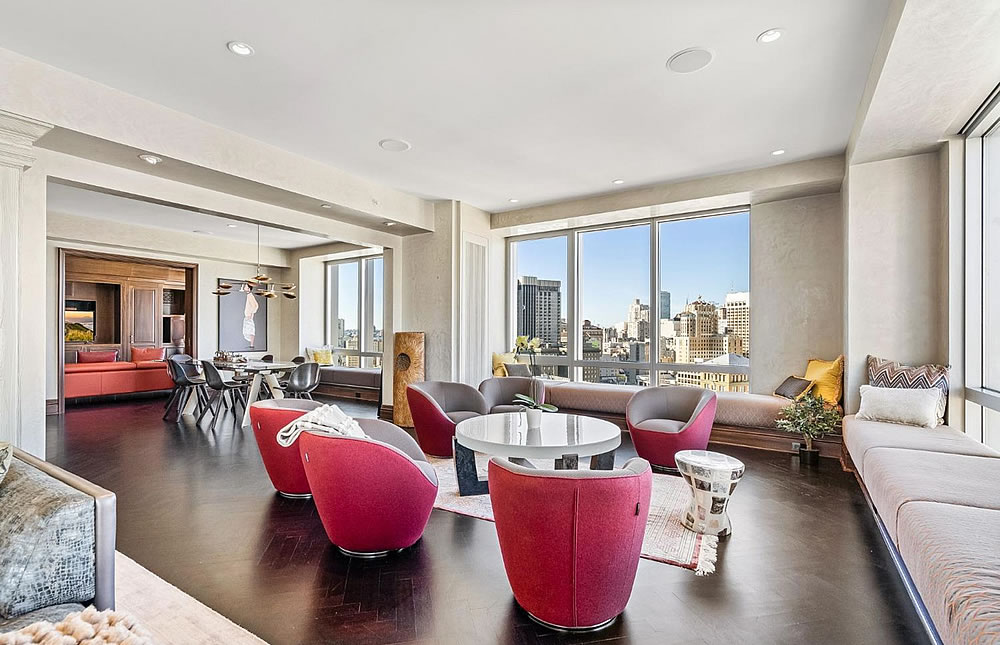At the other end of the Mid-Market condo market, the three-bedroom, 2,569-square-foot unit #28D in the Four Seasons Residences at 765 Market Street sold for $5.475 million in April of 2015.
Featuring walls of windows with panoramic views stretching over the City to the Bay, the corner unit’s formal foyer flows to its “grand salon” (living room) and around to the dining room and kitchen, with the unit’s third bedroom currently outfitted as a media room, custom window seats throughout, and two deeded parking spaces and a storage area in the building’s garage.
Returned to the market priced at $5.475 million earlier this year, a sale at which would have represented net appreciation of 0.0 percent over the past eight years, the asking price for 765 Market Street #28D was reduced to $4.95 million in April but a buyer has yet to emerge. At the same time, the “Motivated Seller!” is now offering the unit for rent at $18,000 a month, which would include the HOA fees of $3,905 a month for those running the numbers at home.
If you think you know the high-end market in San Francisco, now’s the time to tell.











At this price point, architects should figure out how to take advantage of the views while also providing space to hang art and have places for antique chests, built-ins, etc. It would mean some more interior walls, which are out of fashion.
This unit has very little storage. The media room is set-up with the sofa very close to the viewing screen. Bedrooms could have better separation. This layout isn’t very practical. Seems to be designed for someone who won’t spend much time there.
Any readers who can comment on the rent?
It sounds insane, even for the Four Seasons.
Keep in mind that the seemingly “insane” asking rent would yield a whopping 2 percent annual return/CAP rate for the property based on its 2015 purchase price or 2.3 percent based on its reduced list price of $4.95 million, which doesn’t account for any gains/losses in the value of the asset as well.
sunk-cost fallacy
noun
the phenomenon whereby a person is reluctant to abandon a strategy or course of action because they have invested heavily in it, even when it is clear that abandonment would be more beneficial.
A variant, of course, being the belief that something should be priced with regard to historical cost, rather than what it will currently bring in the open market.
Do you mean someone who can comment authoritatively on the number of potential San Francisco residents who want to live in mid-market and can comfortably afford to pay $18k per month in rent but who don’t want to buy a place? I am not that commenter.
I just can’t imagine the number of target high-net-income tenants is large, even in San Francisco. But this isn’t the first place that SS has featured with five-figure monthly rent for a glorified apartment, so there must be an appreciable number of them.
Can’t comment on the current market.
But 7-9 years ago we rented a 3BR/3.5BA half floor condo, similarly sized, 2 parking, unfurnished at Broadway/Webster with ridiculous views for $14k/mo.
The unit/building wasn’t nearly as nice on the inside as the one above, but the neighborhood was 1000x better.
Calibrate as you will.
High end building in what is becoming a not so high-end stretch of Market Street. Why would someone with the means to afford this condo want to live at this location? Street life – not so much. Shopping access – not so much. Westfield just lost it largest tenant after Nordstrom today with Cinemark announcing it is shuttering its theaters next week. Old Navy is gone and on and on. I suspect the price will have to be dropped significantly more before the seller gets any nibbles.
It also just joined the default parade. I provide this link not because it’s a particular good summary; OTC it’s filled with material errors….that’s right, add to the city…excuse me the City’s woes a
newgrowing danger: outright mis-informationThe lender has said they will try to keep the mall going as is. Platitude I suspect as keeping it open with just a handful of tenants will only work for so long. The mayor suggested a different use (pretty much a given) such as an educational institution. Maybe space for non-profits? We’ll see.
Halfish, so not a “handful”….but not exactly healthy. And of course it’s halfish with both of the anchors still open; once Nordstrom actually closes that may get materially worse.
Nordstrom, Cinemark and Bloomies (rumored next year when their lease is up) will bring it well below 45% occupied which IIRC is what it is today.
you live in this building for the amenities – and you don’t walk anywhere anyway
Nordstrom is a glorified Macy’s
typical renter = 3 single tech guys going in together = $6,000/month each (which ain’t bad for what you get) and it’s location makes ubering around quick and easy with easy access to FiDi, SOMA and quick highway access to SV via 6th St entrance (to 101 South)
I’m not seeing this “three rich tech roomies” scenario playing out. All of the techies I know who started out in shared housing moved out to their own place as soon as it was economically feasible.
The three “rich tech roomies” moved to another city where their $6,000 per month can pay the mortgage and taxes on a single-family home for each of them.
This. The comment above from M.O.C.H was clearly appropriate in The Before Times, but now, I don’t think it holds up.
People formerly working in and from San Francisco are getting paid to move to Tulsa, Oklahoma and work remotely nowadays. There, the average price of a home is $191,000. Who needs roommates?
WFH is spreading out the money emanating from Sand Hill Road across the country and indeed, the world.
Are people in Tulsa getting paid S.F. salaries?
Probably not, but they’re getting paid proportionally more of the price of a house
(win,win is the technical term….at least if you restrict the considerations to houses and salary)
Of the several thousand who took Tulsa up on the 10K offer after living there a year, per Fortune, few chose to return to SF or whichever high-priced city they relocated from.
This from Business Insider:
“On the surface, the program seems to have accomplished its aim of luring people with high incomes to town. The more than 2,000 people who received Tulsa Remote grants have a median income of more than $85,000. The Tulsa metro area’s median income was just over $52,000 in 2021, according to census data.”
“Risenhoover said that in all, the more than 2,000 recipients brought a total of $61 million of salary income into the metro between 2019 and 2021, the last full year of data available”.
If I was a young single person who could pay $6K/month in rent, there’s no way would I live in a place with two roommates.
Most of my friends and coworkers with roommates could easily afford $6K/month.
According to the U.S. Census, the median gross rent in San Francisco during the years 2017-2021 was $2,130.
Someone who depends on their job for income and can “easily afford $6K per month” would have to have a salary of ≅ $240,000 per year. The Unadjusted Area Median Income (AMI) for HUD Metro Fair Market Rent Area (HMFA) that Contains San Francisco, establishes the median income for a one-person household in 2023 at $100,850, so you have some friends and coworkers who, while not rich, are clearly in the upper part of the local income distribution.
Nevertheless, I wouldn’t live in a place with two roommates if I had that kind of income at any age.
Many people who could afford $6K/month instead pay much less to live with roommates. But not many people pay $6K to live with two other roommates. (I’m sure it occasionally happens, but it’s very, very rare.)
Almost everyone who pays $6K/month will live either alone or as a part of a domestic partnership.
What floor is this on? The views are blocked. You don’t see much of the Bay or the bridges, just other buildings.
I’m gonna guess it’s on 28.
Elementary, my dear Watson.
young techies don’t buy houses/condos because they know at 25-28 they can get called into an office and offered a promotion and raise – but they have to move to London or Idaho to open a new office and help the company build and lead a team out “there”.
Depends on what kind of tech. If it is the core Silicon Valley business of making chips and computers then odds are very good that the new position will remain in the Bay Area. The only exceptions I’ve experienced are temp gigs to set up a new overseas team. But they always return in a year or two.
UPDATE: Luxury Living in San Francisco for Over a Million Less